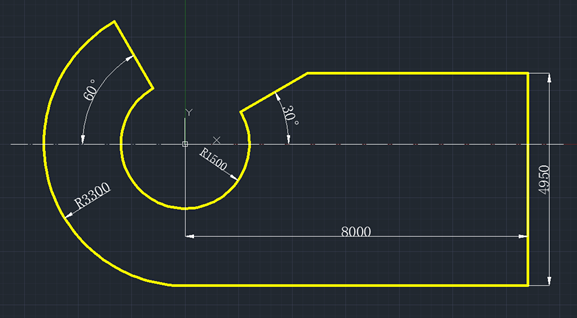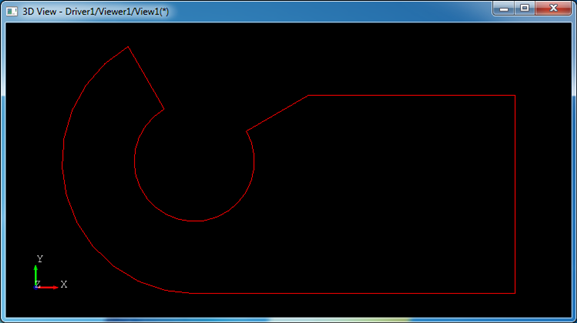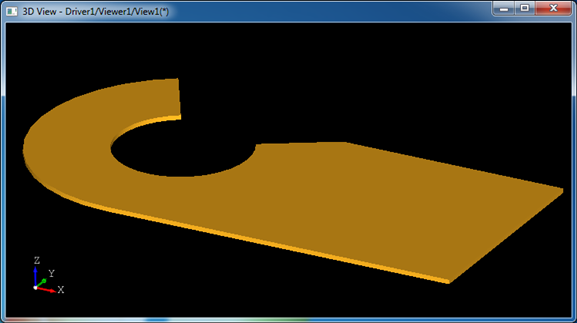OpenCASCADE中散乱Edge生成Wire
OpenCASCADE中散乱Edge生成Wire
Abstract. In OpenCASCADE a wire can be built from any number of edges in sequence. If edges are not in sequence, you must sort them in order.
Key Words. Edge, Wire, Wire order
1. Introduction
在OpenCASCADE中生成WIRE时要求添加到WIRE中的边EDGE是有顺序要求的。当给定的边没有按顺序添加到WIRE之前,需要自己将EDGE按顺序处理。OpenCASCADE中也提供了对EDGE按顺序进行排序的功能,方便WIRE的生成。
本文给出将散乱的EDGE排序后生成WIRE的实现代码,这个功能用处还是很大的。
2. Code
在模型检查模块TKShHealing中,OpenCASCADE提供了类ShapeAnalysis_WireOrder用来将用于生成WIRE的一系列EDGE进行排序。这个类的实现原理是根据EDGE的起点、终点坐标来进行连接,生成顺序。
如下图所示为一个封闭的WIRE,根据这些尺寸标注,生成WIRE的EDGE。
实现上述Wire的程序代码如下所示:
/* The MIT License (MIT) --------------------- Copyright(C) 2018 Shing Liu(eryar@163.com) Permission is hereby granted, free of charge, to any person obtaining a copy of this software and associated documentation files(the "Software"), to deal in the Software without restriction, including without limitation the rights to use, copy, modify, merge, publish, distribute, sublicense, and / or sell copies of the Software, and to permit persons to whom the Software is furnished to do so, subject to the following conditions : The above copyright notice and this permission notice shall be included in all copies or substantial portions of the Software. THE SOFTWARE IS PROVIDED "AS IS", WITHOUT WARRANTY OF ANY KIND, EXPRESS OR IMPLIED, INCLUDING BUT NOT LIMITED TO THE WARRANTIES OF MERCHANTABILITY, FITNESS FOR A PARTICULAR PURPOSE AND NONINFRINGEMENT.IN NO EVENT SHALL THE AUTHORS OR COPYRIGHT HOLDERS BE LIABLE FOR ANY CLAIM, DAMAGES OR OTHER LIABILITY, WHETHER IN AN ACTION OF CONTRACT, TORT OR OTHERWISE, ARISING FROM, OUT OF OR IN CONNECTION WITH THE SOFTWARE OR THE USE OR OTHER DEALINGS IN THE SOFTWARE. */ #include <vector> #include <gp_Pnt.hxx> #include <gp_Circ.hxx> #include <TopTools_ListOfShape.hxx> #include <BRep_Tool.hxx> #include <BRepTools.hxx> #include <BRepBuilderAPI_MakeEdge.hxx> #include <BRepBuilderAPI_MakeWire.hxx> #include <ShapeAnalysis_Edge.hxx> #include <ShapeAnalysis_WireOrder.hxx> #pragma comment(lib, "TKernel.lib") #pragma comment(lib, "TKMath.lib") #pragma comment(lib, "TKG2d.lib") #pragma comment(lib, "TKG3d.lib") #pragma comment(lib, "TKGeomBase.lib") #pragma comment(lib, "TKGeomAlgo.lib") #pragma comment(lib, "TKBRep.lib") #pragma comment(lib, "TKTopAlgo.lib") #pragma comment(lib, "TKShHealing.lib") void test(void) { std::vector<TopoDS_Edge> anEdges; // 5 Segment edges. BRepBuilderAPI_MakeEdge anEdgeMaker1( gp_Pnt(-1650.0, 2857.88383249, 0.0), gp_Pnt(-750.0, 1299.03810568, 0.0)); BRepBuilderAPI_MakeEdge anEdgeMaker2( gp_Pnt(1299.03810568, 750.0, 0.0), gp_Pnt(2857.88383249, 1650.0, 0.0)); BRepBuilderAPI_MakeEdge anEdgeMaker3( gp_Pnt(2857.88383249, 1650.0, 0.0), gp_Pnt(8000.0, 1650.0, 0.0)); BRepBuilderAPI_MakeEdge anEdgeMaker4( gp_Pnt(8000.0, 1650.0, 0.0), gp_Pnt(8000.0, -3300.0, 0.0)); BRepBuilderAPI_MakeEdge anEdgeMaker5( gp_Pnt(8000.0, -3300.0, 0.0), gp_Pnt(0.0, -3300.0, 0.0)); anEdges.push_back(anEdgeMaker1.Edge()); anEdges.push_back(anEdgeMaker2.Edge()); anEdges.push_back(anEdgeMaker3.Edge()); anEdges.push_back(anEdgeMaker4.Edge()); anEdges.push_back(anEdgeMaker5.Edge()); // 2 Arc edges. gp_Circ aCircle1(gp::XOY(), 1500.0); gp_Circ aCircle2(gp::XOY(), 3300.0); BRepBuilderAPI_MakeEdge anEdgeMaker6(aCircle1, gp_Pnt(-750.0, 1299.03810568, 0.0), gp_Pnt(1299.03810568, 750.0, 0.0)); BRepBuilderAPI_MakeEdge anEdgeMaker7(aCircle2, gp_Pnt(-1650.0, 2857.88383249, 0.0), gp_Pnt(0.0, -3300.0, 0.0)); anEdges.push_back(anEdgeMaker6.Edge()); anEdges.push_back(anEdgeMaker7.Edge()); // Get edges order for the wire. ShapeAnalysis_Edge anEdgeAnalyser; ShapeAnalysis_WireOrder aWireOrder; for (std::vector<TopoDS_Edge>::const_iterator i = anEdges.begin(); i != anEdges.end(); ++i) { TopoDS_Vertex aVf = anEdgeAnalyser.FirstVertex(*i); TopoDS_Vertex aVl = anEdgeAnalyser.LastVertex(*i); gp_Pnt aPf = BRep_Tool::Pnt(aVf); gp_Pnt aPl = BRep_Tool::Pnt(aVl); aWireOrder.Add(aPf.XYZ(), aPl.XYZ()); } // TopTools_ListOfShape aOrderedEdges; for (Standard_Integer e = 1; e <= aWireOrder.NbEdges(); ++e) { // const TopoDS_Edge& anEdge = anEdges.at(e - 1);
const TopoDS_Edge& anEdge = anEdges.at(aWireOrder.Ordered(e)); aOrderedEdges.Append(anEdge); } BRepBuilderAPI_MakeWire aWireMaker; aWireMaker.Add(aOrderedEdges); if (aWireMaker.IsDone()) { BRepTools::Write(aWireMaker.Shape(), "d:/wire.brep"); } } int main(int argc, char* argv[]) { test(); return 0; }
程序先添加5条线段到EDGE数组,再添加两个圆弧到EDGE数组。再使用类ShapeAnalysis_WireOrder来对EDGE数组进行排序,将排序后的EDGE数组去生成WIRE。如果生成WIRE成功,会在D盘得到一个wire.brep文件。在Draw中加载后显示如下图所示:
生成WIRE后,继而可以生成FACE,对FACE进行拉伸可以得到拉伸体,如下图所示:
3. Conclusion
OpenCASCADE中生成WIRE时对添加的EDGE是有顺序的要求。如何对散乱的EDGE进行排序以达到生成WIRE的要求呢?OpenCASCADE在TKShHealing模块中提供了对EDGE排序的功能。
对EDGE排序的功能原理很简单,就是将所有的EDGE首尾相连,感兴趣的读者可以结合源码学习下。
为了方便大家在移动端也能看到我的博文和讨论交流,现已注册微信公众号,欢迎大家扫描下方二维码关注。








【推荐】国内首个AI IDE,深度理解中文开发场景,立即下载体验Trae
【推荐】编程新体验,更懂你的AI,立即体验豆包MarsCode编程助手
【推荐】抖音旗下AI助手豆包,你的智能百科全书,全免费不限次数
【推荐】轻量又高性能的 SSH 工具 IShell:AI 加持,快人一步
· AI与.NET技术实操系列:向量存储与相似性搜索在 .NET 中的实现
· 基于Microsoft.Extensions.AI核心库实现RAG应用
· Linux系列:如何用heaptrack跟踪.NET程序的非托管内存泄露
· 开发者必知的日志记录最佳实践
· SQL Server 2025 AI相关能力初探
· winform 绘制太阳,地球,月球 运作规律
· AI与.NET技术实操系列(五):向量存储与相似性搜索在 .NET 中的实现
· 超详细:普通电脑也行Windows部署deepseek R1训练数据并当服务器共享给他人
· 【硬核科普】Trae如何「偷看」你的代码?零基础破解AI编程运行原理
· 上周热点回顾(3.3-3.9)